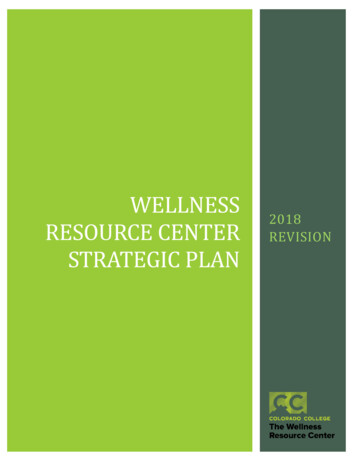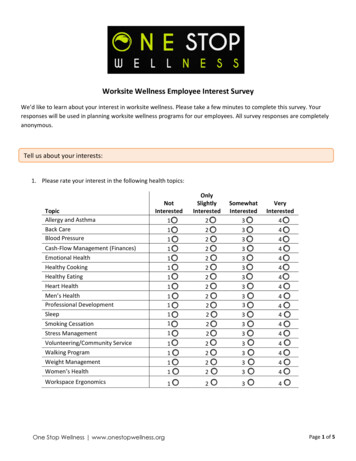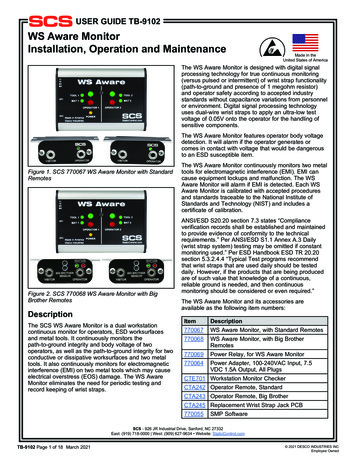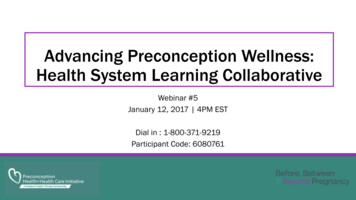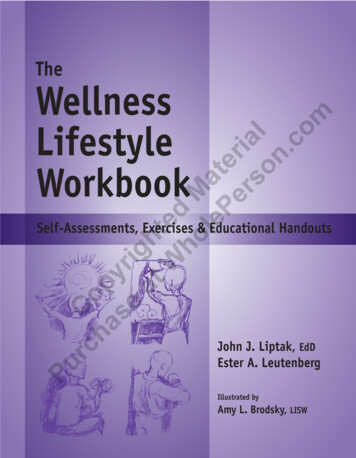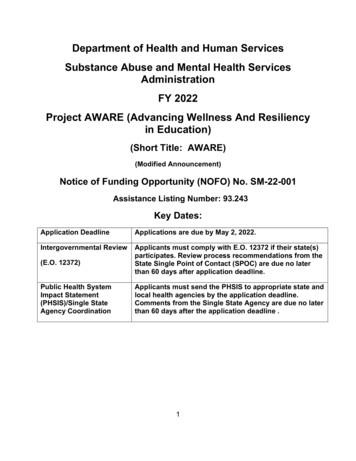
Transcription
Department of Health and Human ServicesSubstance Abuse and Mental Health ServicesAdministrationFY 2022Project AWARE (Advancing Wellness And Resiliencyin Education)(Short Title: AWARE)(Modified Announcement)Notice of Funding Opportunity (NOFO) No. SM-22-001Assistance Listing Number: 93.243Key Dates:Application DeadlineApplications are due by May 2, 2022.Intergovernmental Review(E.O. 12372)Applicants must comply with E.O. 12372 if their state(s)participates. Review process recommendations from theState Single Point of Contact (SPOC) are due no laterthan 60 days after application deadline.Public Health SystemImpact Statement(PHSIS)/Single StateAgency CoordinationApplicants must send the PHSIS to appropriate state andlocal health agencies by the application deadline.Comments from the Single State Agency are due no laterthan 60 days after the application deadline .1
Table of ContentsEXECUTIVE SUMMARY. 5I.PROJECT DESCRIPTION . 71. PURPOSE . 72. KEY PERSONNEL . 93. REQUIRED ACTIVITIES . 94. ALLOWABLE ACTIVITIES . 125. DATA COLLECTION/PERFORMANCE MEASUREMENT ANDPROJECTPERFORMANCE ASSESSMENT . 126. OTHER EXPECTATIONS . 147. GRANTEE MEETINGS. 16II. FEDERAL AWARD INFORMATION . 161. GENERAL INFORMATION . 16III. ELIGIBILITY INFORMATION . 171. ELIGIBLE APPLICANTS . 172.COST SHARING AND MATCHING REQUIREMENTS . 173.OTHER REQUIREMENTS . 17IV. APPLICATION AND SUBMISSION INFORMATION . 181.ADDRESS TO REQUEST APPLICATION PACKAGE . 182. CONTENT AND FORM OF APPLICATION SUBMISSION . 183. UNIQUE ENTITY IDENTIFIER AND SYSTEM FOR AWARD MANAGEMENT(SAM). 224. APPLICATION SUBMISSION REQUIREMENTS . 225. FUNDING LIMITATIONS/RESTRICTIONS . 222
6. INTERGOVERNMENTAL REVIEW (E.O. 12372) REQUIREMENTS . 237. OTHER SUBMISSION REQUIREMENTS . 23V. APPLICATION REVIEW INFORMATION . 231. EVALUATION CRITERIA . 232. BUDGET JUSTIFICATION, EXISTING RESOURCES, OTHER SUPPORT . 263. REVIEW AND SELECTION PROCESS . 26VI. FEDERAL AWARD ADMINISTRATION INFORMATION . 281.FEDERAL AWARD NOTICES . 282.ADMINISTRATIVE AND NATIONAL POLICY REQUIREMENTS . 283.REPORTING REQUIREMENTS . 28VII. AGENCY CONTACTS . 29Appendix A – Application and Submission Requirements . 311. GET REGISTERED . 312. WRITE AND COMPLETE APPLICATION . 343. SUBMIT APPLICATION . 374. AFTER SUBMISSION . 39Appendix B - Formatting Requirements and System Validation . 421. SAMHSA FORMATTING REQUIREMENTS. 422. GRANTS.GOV FORMATTING AND VALIDATION REQUIREMENTS . 423. eRA COMMONS FORMATTING AND VALIDATION REQUIREMENTS . 43Appendix C – General Eligibility Information . 48Appendix D – Confidentiality and SAMHSA Participant Protection/Human SubjectsGuidelines . 49Appendix E – Developing Goals and Measurable Objectives . 533
Appendix F – Developing the Plan for Data Collection and Performance Measurement .56Appendix G – Biographical Sketches and Position Descriptions . 59Appendix H – Addressing Behavioral Health Disparities . 60Appendix I – Standard Funding Restrictions . 64Appendix J – Intergovernmental Review (E.O. 12372) Requirements . 66Appendix K – Administrative and National Policy Requirements. 68Appendix L – Sample Budget and Justification . 74Appendix M – Three-tiered Public Health Model . 794
EXECUTIVE SUMMARYThe Substance Abuse and Mental Health Services Administration (SAMHSA), Centerfor Mental Health Services (CMHS), is accepting applications for fiscal year (FY) 2022Project AWARE (Advancing Wellness And Resiliency in Education) grants (short title:AWARE). The purpose of Project AWARE is to develop a sustainable infrastructure forschool-based mental health programs and services. It is expected that the recipient willbuild a collaborative partnership that includes the State Education Agency (SEA), theLocal Education Agency (LEA), the State Mental Health Agency (SMHA), communitybased providers of behavioral health care services, school personnel, communityorganizations, families, and school-aged youth. Based on a public health model, thispartnership will implement mental health related promotion, awareness, prevention,intervention, and resilience activities to ensure that students have access and areconnected to appropriate and effective behavioral health services. SAMHSA expectsthat this program will promote the healthy social and emotional development of schoolaged youth and prevent youth violence in school settings.Funding Opportunity Title:Project AWARE (Advancing Wellnessand Resiliency in Education) (Short title:AWARE)Funding Opportunity Number:SM-22-001Due Date for Applications:May 2, 2022Estimated Total Available Funding: 5,400,000 (Funding for this program isfrom the American Rescue Plan Act)Estimated Number of Awards:3Estimated Award Amount:Up to 1,800,000 per year, per awardCost Sharing/Match RequiredNoAnticipated Project Start Date:9/30/2022Anticipated Award Date:8/31/2022Length of Project Period:Up to 5 years5
Eligible Applicants:Eligible entities are States; politicalsubdivisions of States (e.g., county, LEA);Indian tribes or tribal organizations (asdefined in section 5304 of title 25), healthfacilities, or programs operated by or inaccordance with a contract or grant withthe Indian Health Service, or otherdomestic public or private nonprofitentities.).[See Section III-1 for complete eligibilityinformation.]Authorizing Statute:Section 520A of the Public Health ServiceAct (42 USC 290bb-32), as amended.6
Be sure to check the SAMHSA website periodically for any updates on thisprogram.All applicants MUST register with NIH’s eRA Commons in order to submit anapplication. This process takes up to six weeks. If you believe you areinterested in applying for this opportunity, you MUST start the registrationprocess immediately. Do not wait to start this process.WARNING: BY THE DEADLINE FOR THIS NOFO YOU MUST HAVESUCCESSFULLY COMPLETED THE FOLLOWING TO SUBMIT AN APPLICATION: The applicant organization MUST be registered in NIH’s eRA Commons;AND The Project Director MUST have an active eRA Commons account (withthe PI role) affiliated with the organization in eRA Commons.No exceptions will be made.Applicants must also register with the System for Award Management (SAM) andGrants.gov (see Appendix A of this NOFO for all registration requirements).DO NOT WAIT UNTIL THE LAST MINUTE TO SUBMIT THE APPLICATION. If youwait until the last minute, there is a strong possibility that the application willnot be received without errors by the deadline.I.PROJECT DESCRIPTION1. PURPOSEThe purpose of Project AWARE is to develop a sustainable infrastructure for schoolbased mental health programs and services. It is expected that the recipient will build acollaborative partnership that includes the State Education Agency (SEA), the LocalEducation Agency (LEA), Tribal Education Agency (TEA), the State Mental HealthAgency (SMHA), community-based providers of behavioral health care services, schoolpersonnel, community organizations, families, and school-aged youth. Based on apublic health model, this partnership will implement mental health related promotion,awareness, prevention, intervention, and resilience activities to ensure that studentshave access and are connected to appropriate and effective behavioral health services.SAMHSA expects that this program will promote the healthy social and emotionaldevelopment of school-aged youth and prevent youth violence in school settings.7
The goals of AWARE are to: Increase awareness of mental health, substance use, and co-occurring issuesamong school-aged youth. Increase the knowledge of individuals who interact with school-aged youth tounderstand and detect the signs and symptoms of mental health, substance use,and co-occurring disorders. Promote resilience building and mental health well-being for all school-agedyouth. Create and sustain a school-based mental health system that is based on athree-tiered public health model. A three-tiered public health model for providingsupports to school-aged youth to promote positive behavioral health supports(universal/promotion); targeted services to those who need more support(secondary prevention); and intensive services to those who need them (tertiaryintervention). [NOTE: Refer to Appendix M for more information about the threetiered public health model]. Develop a referral pathway system that connects school-aged youth who mayhave behavioral health issues, including serious emotional disturbance (SED) orserious mental illness (SMI), and their families to needed services. Increase and improve access to culturally relevant, developmentally appropriate,and trauma informed school and community-based AWARE grant activities andservices.The population of focus is school-aged youth (i.e., children and youth in grades K-12).AWARE grants are authorized under Section 520A of the Public Health Service (PHS)Act (42 USC 290bb-32), as amended.NOTE: In alignment with the STANDUP Act of 2021(P.L. 117-100), which amends thePHS Act to include Section 520B (42 USC 290bb-32). SAMHSA will prioritize fundingby giving 5 additional points to SEAs, LEAs, and TEAs (submitted directly or through aState or Indian Tribe) who have implemented or plan to implement a student suicideawareness and prevention training policy in secondary schools. The student suicideawareness and prevention training policy may include as applicable youth suicide earlyintervention and prevention strategies found in Section 520-E of the PHS Act, asamended. Applicants must submit the requested information in Attachment 9 to receivethe 5 additional points. See Section I.4 Allowable Activities for more information.8
2. KEY PERSONNELKey personnel are staff members who must be part of the project regardless of whetheror not they receive a salary or compensation from the project. These staff membersmust make a substantial contribution to the execution of the project.The Key Personnel for this program is the Project Director with a level of effort of 1.0FTE. Additional Key Personnel are the following: If the SEA is the applicant:o At least 0.25 FTE for a SMHA Coordinator ando A 1.0 FTE Project Manager for each of the LEA(s). If the LEA is the applicant:o At least .25 FTE for a SEA Coordinator ando A 0.25 FTE a SMHA Coordinator. If the applicant is a domestic community based non-profit provider ofbehavioral health services:o At least .25 FTE for a SEA Coordinator,o A 0.25 FTE for a SMHA Coordinator, ando A 1.0 FTE Project Manager for each of the LEA(s). If the applicant is a political sub-division of the state:o At least 0.25 FTE for a SEA Coordinator,o At least 0.25 FTE for a SMHA Coordinator, ando A 1.0 FTE Project Manager for each of the LEA(s).These positions require prior approval by SAMHSA after a review of staffcredentials and job descriptions.3. REQUIRED ACTIVITIESRequired activities are the activities that every AWARE grant must implement.They must be reflected in the Project Narrative of your application. This is inresponse to Section V of this NOFO. Develop a collaborative partnership between at least one Local Education Agency(LEA), the State Education Agency (SEA), the State Mental Health Agency (SMHA),and at least one local community public or private non-profit provider of behavioralhealth services. [NOTE: A Letter of Commitment (LOC) from each9
agency/behavioral health service provider must be included in Attachment 1. TheLOCs must list the specific activities, responsibilities, and designated staff that eachagency/provider will commit to the project. Applicants who do not submit therequired LOCs will be screened out and not reviewed.]o If the applicant is the SEA, the SEA is required to partner with the SMHA, at leastone LEA, and at least one community-based private or public non-profit providerof behavioral health services that is located in the LEA(s) geographic catchmentarea.o If the applicant is the LEA, the LEA is required to partner with the SEA, theSMHA, and at least one community-based public or private non-profit provider ofbehavioral health services that is located in the LEA’s geographic catchmentarea. The LEA can include other LEAs in the grant project.o If the applicant is a community-based public or private non-profit provider ofbehavioral health services, the provider must partner with at least one LEA, theSEA, and the SMHA.o If the applicant is a community-based public or private non-profitorganization, the organization must partner with a provider of behavioral healthservices, at least one LEA, the SEA, and the SMHA.o If the applicant is a political sub-division of the state (e.g., county, city, town),it must partner with at least one LEA, the SEA, the SMHA, and at least onecommunity-based public or private non-profit provider of behavioral healthservices located in the LEA geographic catchment area.o If the applicant is a tribal organization or consortia of tribes, the tribalorganization/consortia must partner with the Education Agency/Authorityoverseeing American Indian/Alaska Native school-aged youth, and a localcommunity-based private or public non-profit provider of behavioral healthservices. They can consider partnering with other LEAs if appropriate. In consultation with the required partners, conduct a needs assessment of theLEA(s) and its geographic catchment area to identify the service gaps and extent ofthe need with current prevalence rates and incidence data. No later than six months after award, develop an implementation plan that includesthe following:o A three-tiered public health model for providing supports to school-aged youth topromote positive behavioral health supports (universal/promotion); targetedservices to those who need more support (secondary prevention); and intensiveservices to those who need them (tertiary intervention). The three-tieredapproach must be culturally competent, trauma-informed, developmentallyappropriate, evidence-based, or evidence-informed, and address the effects of10
COVID-19. 1 [NOTE: Additional information about the three-tiered model can befound in Appendix M.]o The referral pathways to ensure that school-aged youth in of need moreassistance than brief intervention are referred to and receive necessary schoolbased and/or community mental health, substance use, and co-occurringsupports and services. If necessary, MOUs and other partnership mechanismsshall be established to secure referral pathways.o A workforce capacity-building plan to increase the mental health awareness andliteracy of school staff, administrators, parents, and others who interact withschool-aged youth to recognize the signs and symptoms of mental health issuesand link them to appropriate services.o A plan to ensure that the LEA can respond immediately if a school-aged youthexhibits mental health issues warranting the need for clinical attention.o A description of the school safety and threat/violence prevention plan for eachLEA identified in the application. No later than the end of Year 2, develop a sustainability plan that would include, butnot be limited to, changes in policy that support the infrastructure to maintain andpossibly expand behavioral health services and supports for students when federalfunding ends. Establish an advisory board that includes key stakeholders to support improvementin school-aged youth and family-serving school-based mental health systems. Anexisting advisory board may be used as long as it meets the criteria delineated here.The advisory board must include representatives from the LEA, SEA, SMHA, familymembers, school personnel, and youth. Other members may include juvenile justicerepresentatives, Statewide Family Network members, local National Alliance onMental Illness (NAMI) representatives if they have experience in children’s mentalhealth, and other coalition and community groups as appropriate. The advisoryboard may consider developing a plan to integrate local, state, and federal fundingstreams that support programs with similar goals to ensure the sustainability ofeffective school-based mental health programs.Applicants may reference the National Center for Pyramid Model Interventions (NCPMI) /overview/tiers.html111
4.Establish collaborative relationships with families, community groups, and localbusinesses to broaden and link available community resources to school-aged youthand their families.ALLOWABLE ACTIVITIESAllowable activities can be supported with grant funds but are not required. Allowableactivities may include: Providing supports to assist teachers and school personnel to develop skills thatpromote staff wellness, mental well-being, and resilience to better support and referschool-aged youth with behavioral health issues to needed services. For SEAs, LEAs, and TEAs only, establishing and implementing a schoolbased student suicide awareness and prevention training policy which must: Beevidence-basedBe culturally and linguistically appropriateProvide evidence-based training to students in grades 6 through 12, incoordination with school-based mental health resources, regarding:i.Suicide prevention education and awareness, including associated riskfactors;ii.Methods that students can use to seek help; andiii.Student resources for suicide awareness and prevention. Provide for periodic re-training of students. NOTE: SEAs, LEAs, and TEAs applicants who select this allowable activity mustinclude the following in Attachment 9 to receive the 5 additional points:o A description for how the required data in Section I.6 will be collected andreported; ANDo For applicants that have implemented a student suicide awarenessprevention training policy, provide the training policy and a description howthe training policy will be or has been implemented in secondary schools,ORo For applicants that have not developed a student suicide awarenessprevention training policy, include a description how the training policy willbe developed and implemented in secondary schools.5.DATA COLLECTION/PERFORMANCE MEASUREMENT AND PROJECTPERFORMANCE ASSESSMENTData Collection/Performance Measurement12
All SAMHSA recipients are required to collect and report performance measures so thatSAMHSA can meet its obligations under the Government Performance and Results(GPRA) Modernization Act of 2010. You must document your plan for data collectionand reporting in your Project Narrative in response to Section D: Data Collection andPerformance Measurement of Section V of this NOFO.Recipients are required to report performance on the following measures:o The number of individuals who have received training in prevention or mentalhealth promotion.o The number of organizations that entered into formal written inter/intraorganizational agreements (e.g., MOUS/ MOAS) to improve mental healthrelated practices/activities that are consistent with the goals of the grant.o The number of policy changes completed as a result of the grant.o The number of individuals screened for mental health or related interventions.o The number of individuals referred to mental health or related services.o The number and percentage of individuals receiving mental health or relatedservices after referral.o The number and percentage of individuals who have demonstrated improvement,between pre and post-test, in knowledge/attitudes/beliefs related to preventionand/or mental health promotion as a result of the training activity.This information will be gathered using a uniform data collection tool provided bySAMHSA. Recipients are required to submit data via SAMHSA’s PerformanceAccountability and Reporting System (SPARS); and access will be provided uponaward. Additional information about SPARS can be found at SPARS (samhsa.gov)Data will be collected quarterly. Data are to be collected and entered into the webbased portal.The SEAs, LEAs, and TEAs that have selected the allowable activity described inSection I.4 are required to report performance on the following measures in their annualperformance assessment report: Number of trainings conducted, including the number of student trainingsconducted and the training delivery methods used. The number of students trained, disaggregated by age and grade level. Number of help-seeking reports made by students after implementation of thepolicy.13
The collection of these performance measures data enables SAMHSA to report on keyoutcomes relating to the grant program. In addition to these outcomes, performancemeasure data collected by recipients will be used to assess the impact of SAMHSA’sgrant programs on reducing disparities in behavioral health access, service use, andoutcomes nationwide.Performance measures data will be reported to the public as part of SAMHSA’sCongressional Justification.A national evaluation is required to build the evidence base for this program. Recipientsare required to participate fully in all aspects of the national cross-site evaluation. Thismay include collection of additional client-level data and participation of sub-recipients.Details on the evaluation, including type of evaluation and research questions, will beprovided upon award.Project Performance AssessmentRecipients must periodically review the performance measures data they report toSAMHSA (as required above), assess their progress, and use this information toimprove the management of their grant project. Recipients are also required to report ontheir progress addressing the goals and objectives identified in your Project Narrative.The project performance assessment should be designed to help you determinewhether you are achieving the goals, objectives, and outcomes you intend to achieveand whether adjustments need to be made to your project. Performance assessmentsshould be used to determine whether your project is having/will have the intendedimpact on behavioral health disparities.Note: See Appendix E and Appendix F of this NOFO for more information onresponding to this section.6.OTHER EXPECTATIONSSAMHSA Values That Promote Positive Behavioral HealthSAMHSA expects recipients to use grant funds to implement high quality programs,practices, and policies that are recovery-oriented, trauma-informed, and equity-basedas a means of improving behavioral health. 2“Behavioral health” means the promotion of mental health, resilience and wellbeing; the treatment ofmental and substance use disorders; and the support of those who experience and/or are in recoveryfrom these conditions, along with their families and communities.214
Recovery is a process of change through which individuals improve their health andwellness, live a self-directed life, and strive to reach their full potential. Recoveryoriented recipients promote partnerships with people in recovery from mental andsubstance use disorders and their family members to guide the behavioral healthsystem and promote individual, program, and system-level approaches that foster:Health—managing one’s illnesses or symptoms and making informed healthy choicesthat support physical and emotional wellbeing; Home—a stable and safe place to live;Purpose—meaningful daily activities such as a job or school; and Community—supportive relationships with families, friends and peers. Recovery oriented systems ofcare embrace recovery as: emerging from hope; person-driven; occurring via manypathways; holistic; supported by peers and allies; culturally-based and influenced;supported through relationship and social networks; involving individual, family, andcommunity strengths and responsibility; supported by addressing trauma; and based onrespect.Trauma-informed care recognizes and intentionally responds to the lasting adverseeffects of experiencing traumatic events. Trauma-informed care is defined through sixkey principles: Safety: participants and staff feel physically and psychological safe; Peersupport: peer support and mutual self-help as vehicles for establishing safety and hope,building trust, enhancing collaboration, and utilizing their lived experience;Trustworthiness and Transparency: decisions are conducted with the goal of buildingand maintaining trust; Collaboration and Mutuality: importance is placed on partneringand leveling power differences; Cultural, Historical, & Gender Issues: culture andgender-responsive services are offered while moving beyond stereotypes/biases; andEmpowerment, Voice and Choice: organizations foster a belief in the primacy of thepeople who are served to heal and promote recovery from trauma. 3 It is criticalrecipients promote the linkage to recovery and resilience for those individuals andfamilies impacted by trauma.Behavioral health equity is the right to access high quality and affordable health careservices and supports for all populations regardless of the individual’s race, age,ethnicity, gender, disability, socioeconomic status, sexual orientation, or geographicallocation. By improving access to behavioral health care, promoting quality behavioralhealth programs and practice, and reducing persistent disparities in mental health andsubstance use services for underserved populations and communities, recipients canensure that everyone has a fair and just opportunity to be as healthy as possible. Inconjunction with promoting access to high quality services, behavioral health disparitiescan be further mitigated by addressing social determinants of health, such as AMHSA Trauma.pdf15
exclusion, unemployment, adverse childhood experiences, and food and housinginsecurity.Behavioral Health DisparitiesIf your application is funded, you will be expected to develop a behavioral healthdisparity impact statement no later than 60 days after your award. (See Appendix H –Addressing Behavioral Health Disparities).The behavioral health disparity impact statement is in alignment with the expectationsrelated to Executive Order 13985 “Advancing Racial Equity and Support forUnderserved Communities Through the Federal Government.”Tribal Behavioral Health AgendaSAMHSA, working with tribes, the Indian Health Service, and National Indian HealthBoard developed the first collaborative National Tribal Behavioral Health Agenda(TBHA). Tribal applicants are encouraged to briefly cite the applicable TBHAfoundational element(s), priority(ies), and strategies that are addressed by their grantapplication. The TBHA can be accessed 4-16.pdf.Tobacco and Nicotine Free PolicySAMHSA strongly encourages all recipients to adopt a tobacco/nicotine inhalation(vaping) product-free facility/grounds policy and to promote abstinence from all tobaccoproducts (except in regard to accepted tribal traditions and practices).7.GRANTEE MEETINGSRecipient meetings will be held virtually, and recipients are expected to fully participatein these meetings. If SAMHSA elects to hold an in-person meeting, budget revisions willbe permitted.II.FEDERAL AWARD INFORMATION1. GENERAL INFORMAT
o A 1.0 FTE Project Manager for each of the LEA(s). If the applicant is a political sub-division of the state: o At least 0.25 FTE for a SEA Coordinator, o At least 0.25 FTE for a SMHA Coordinator, and o A 1.0 FTE Project Manager for each of the LEA(s). These positions require prior approval by SAMHSA after a review of staff
